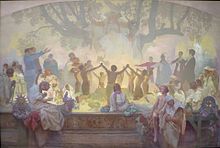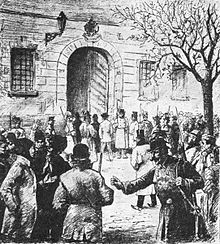Omladina
Reason: There are no individual references, only Czech-language literature without bibliographical data is given.
As Omladina one was anarchist , Czech secret society called, made up of the younger generation of the workers' movement was formed in the late 19th century. However, this union also joined student movements whose goals expressed themselves in radicalism , individualism and voluntarism . Over time, this political grouping moved further and further away from political parties and the social democracy from which they originally organized themselves. Ideological models for the secret society were Stanislav Kostka Neumann and Friedrich Nietzsche .
The name "Omladina", which could best be translated into German as youth, was given to the group by the police and the state organs, who viewed this organization as a secret society that was dangerous to the state and turned against the Austro-Hungarian monarchy . In fact, it was a reform movement that fought for state independence and was one of the accompanying phenomena of the socialist movement that was beginning in the Czech Republic .
On September 12, 1893, a state of emergency was declared in Prague and many members and leaders were arrested and brought to a special court. On February 14, 1894, 68 suspects were convicted of high treason, insulting the emperor and the court, violating public order, forming a secret society and disturbing the public peace. A total of 96 years, two months and 28 days were imposed.
Among the convicts were the editor Karel Stanislav Sokol , the politician and later finance minister Dr. Alois Rašín , the journalist Josef Škába , the publicist Antonin Hajn , the politician and journalist František Modráček , the poet Stanislav Kostka Neumann , the writer Alois Tuček and Jan Ziegloser , who received the highest prison sentence at eight years. After the formation of the Czechoslovak Republic, the Political Club Omladina was re-established in 1919 .
The individual groups were divided into so-called thumbs and fingers. The individual fingers of a group chose a thumb, which in turn chose four fingers, which in turn chose a thumb. Although the first thumb knows all the other thumbs, the individual thumbs and fingers of other groups do not know each other.
The secret society was headed by the so-called dictator. From him the commands came to the thumbs, which in turn instructed the fingers.
Omladina published its own magazine Our Omladina (Naše omladina) and in 1911 founded the so-called Beekeeping Association (Včelařský spolek). Other magazines such as Modern Revue ( Moderní revue ), New Cult ( Nový kult ) or New Epoch of Freedom (Nový věk svobody) brought the thoughts of European anarchists closer to the youth.
literature
- Antonín Pravoslav Veselý: Omladina a pokrok. hnutí (1902)
- Anna Ziegloserová: Omladina (1924)
- Josef Soukup: Omladináři (1930)

